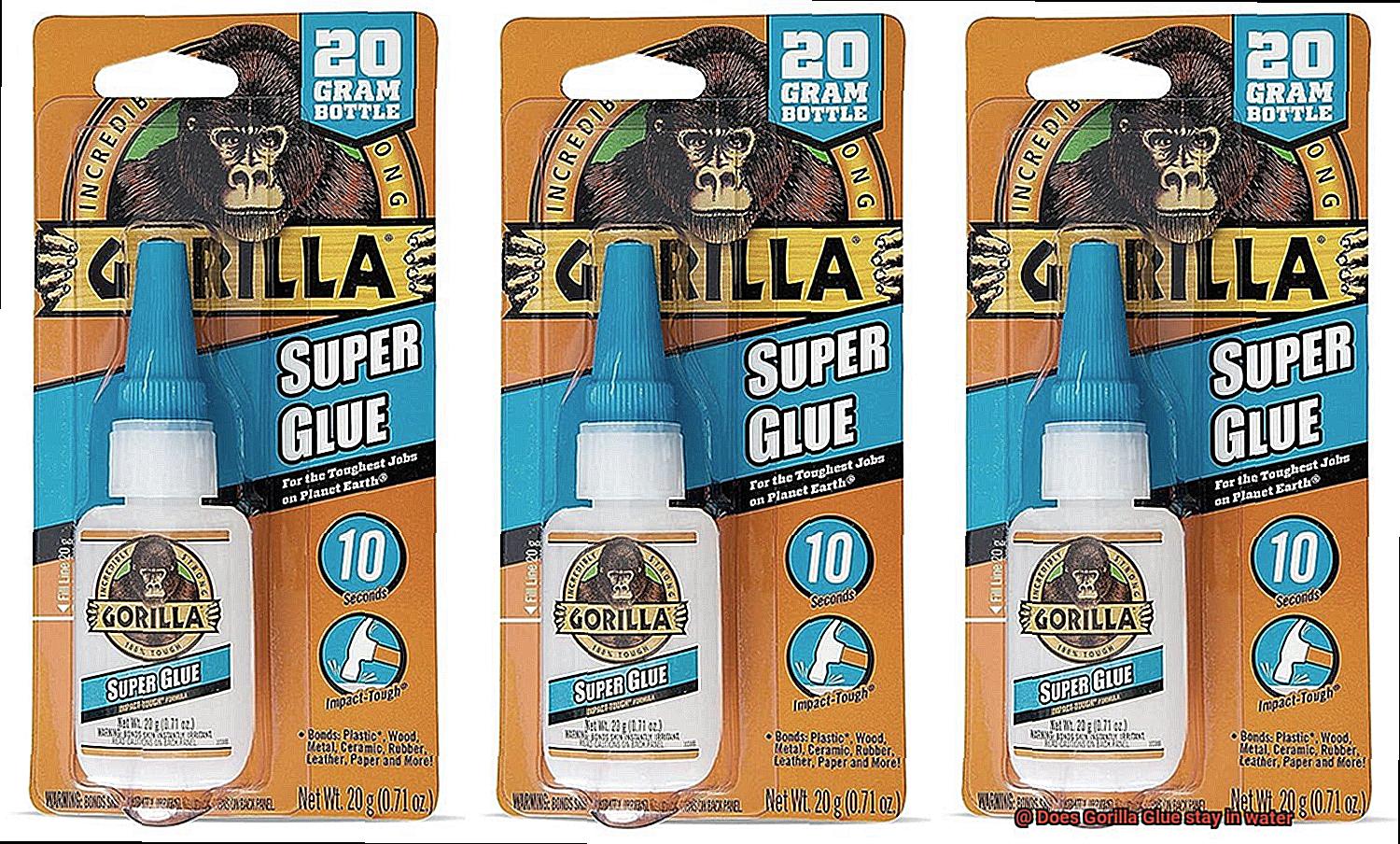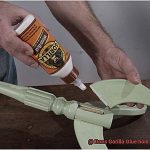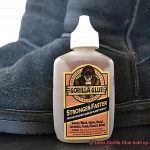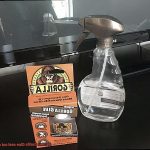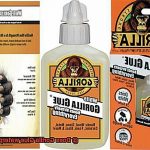Have you ever wondered if Gorilla Glue can hold up in water? As a go-to adhesive for DIY enthusiasts, this is a question worth exploring. Some people believe that the glue will lose its grip when it comes into contact with water, while others argue that it’s designed to withstand wet environments. So, what’s the truth?
Here’s the deal: Gorilla Glue is a polyurethane-based adhesive that boasts exceptional strength and water-resistance. It’s specifically formulated to form robust bonds in damp conditions, making it an ideal choice for projects that may come into contact with moisture. However, let’s be clear – “water-resistant” doesn’t equal “waterproof.” If not applied correctly or exposed to prolonged submersion, Gorilla Glue can still be compromised.
In this blog post, we’ll explore the science behind how Gorilla Glue works in water and investigate some of the factors that can affect its strength. Whether you’re planning a project near water or just curious about this popular adhesive’s capabilities, keep reading to find out if Gorilla Glue stays put in water.
What is Gorilla Glue?
Contents
- 1 What is Gorilla Glue?
- 2 Is Gorilla Glue Waterproof?
- 3 How Does Gorilla Glue Resist Water?
- 4 Advantages of Using Gorilla Glue in Wet Conditions
- 5 Limitations of Using Gorilla Glue in Wet Conditions
- 6 Tips for Using Gorilla Glue in Wet Conditions
- 7 Alternatives to Gorilla Glue for Waterproofing Projects
- 8 Conclusion
When it comes to adhesives, few are as powerful and versatile as Gorilla Glue. First introduced in 1999, this polyurethane-based adhesive has since become a household name among DIY enthusiasts and professionals alike. What sets Gorilla Glue apart from other adhesives is its incredible ability to bond an array of materials together, including wood, metal, ceramic, foam, glass, and certain plastics.
What makes Gorilla Glue unique is the chemical reaction that occurs when it comes into contact with moisture. This reaction causes the glue to expand and create a strong bond that can withstand even the toughest conditions. It’s no wonder why it’s a top choice for projects that will be exposed to water or humidity. Gorilla Glue is waterproof, which means it can handle exposure to moisture without losing its bonding power. This makes it perfect for outdoor projects such as repairing outdoor furniture, sealing leaks in pipes or aquariums.
Not only is Gorilla Glue waterproof, but it also dries to a tan color and can be sanded or painted over once it has cured. It takes about 10-20 minutes for the glue to set and 24 hours for it to fully cure. However, it’s essential to use Gorilla Glue carefully since it can be challenging to remove once it has cured. Avoid getting it on surfaces or materials that you do not want it on.
Gorilla Glue’s versatility makes it an excellent choice for various DIY projects and professional applications. From fixing broken items to creating new ones from scratch, this adhesive can handle just about anything. Whether you’re working with wood, metal, ceramic or other materials, Gorilla Glue is sure to provide a strong and durable bond that will last for years.
Is Gorilla Glue Waterproof?
Then, Gorilla Glue is the answer. As an expert in this area, I can confidently tell you that Gorilla Glue is indeed waterproof.
Gorilla Glue is a polyurethane-based adhesive renowned for its exceptional strength and versatility. What makes it stand out from other adhesives is its unique chemical composition that makes it resistant to water and other liquids. When it comes into contact with moisture, Gorilla Glue undergoes a chemical reaction that causes it to expand and form a tight bond with the surface it’s applied to. This reaction also makes the glue heat-resistant, ensuring it can withstand extreme temperatures.
Gorilla Glue is perfect for outdoor projects where exposure to water or other elements is likely. Whether you’re repairing outdoor furniture, sealing leaks in pipes or aquariums, Gorilla Glue is a reliable choice. Its waterproof properties make it ideal for use in situations where water damage might be a concern.
While Gorilla Glue is waterproof, it’s not suitable for underwater applications. The expansion properties of the glue can cause bubbling and foaming when it comes into contact with water, which can compromise its strength. Therefore, keep this in mind before using the glue in any underwater applications.
How Does Gorilla Glue Resist Water?
If yes, then Gorilla Glue is the ultimate solution for all your waterproofing needs. This versatile adhesive is known for its strength and durability, but what sets it apart is its ability to resist water. As an expert on this topic, let me explain how Gorilla Glue resists water.
Gorilla Glue’s chemical composition is the key to its resistance to water. Its moisture-activated polyurethane formula requires water to cure properly. When the glue comes into contact with water, it undergoes a chemical reaction that causes it to expand and harden. The expansion creates a tight bond between the surfaces being glued together, making it resistant to any water that may come its way.
But wait, there’s more. Gorilla Glue’s closed-cell structure also plays a vital role in its water resistance. This structure gives the glue a high degree of density, making it less permeable to water and allowing it to maintain its strength even when exposed to prolonged periods of moisture.
So, even if you have a project that requires exposure to moisture or damp conditions, Gorilla Glue has got you covered. Whether you’re repairing outdoor furniture or creating a waterproof seal on your boat, Gorilla Glue is an excellent choice.
It’s important to note that while Gorilla Glue is highly resistant to water, it’s not completely waterproof. In very wet conditions or when submerged in water for extended periods of time, the glue may eventually break down and lose its hold.
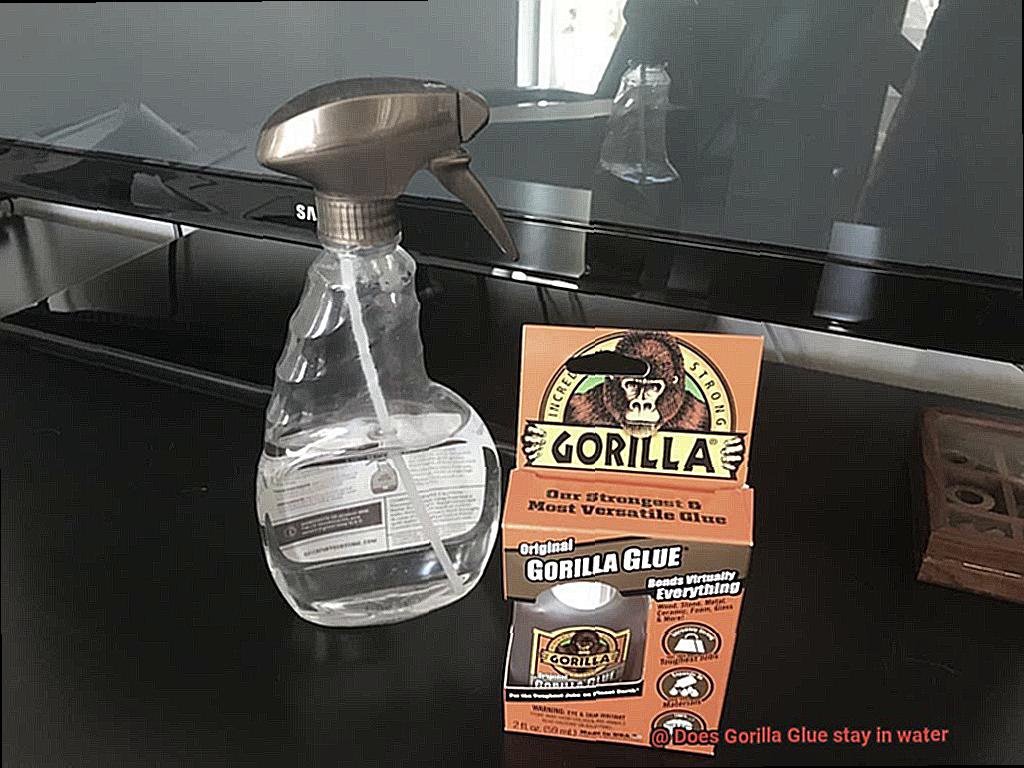
Advantages of Using Gorilla Glue in Wet Conditions
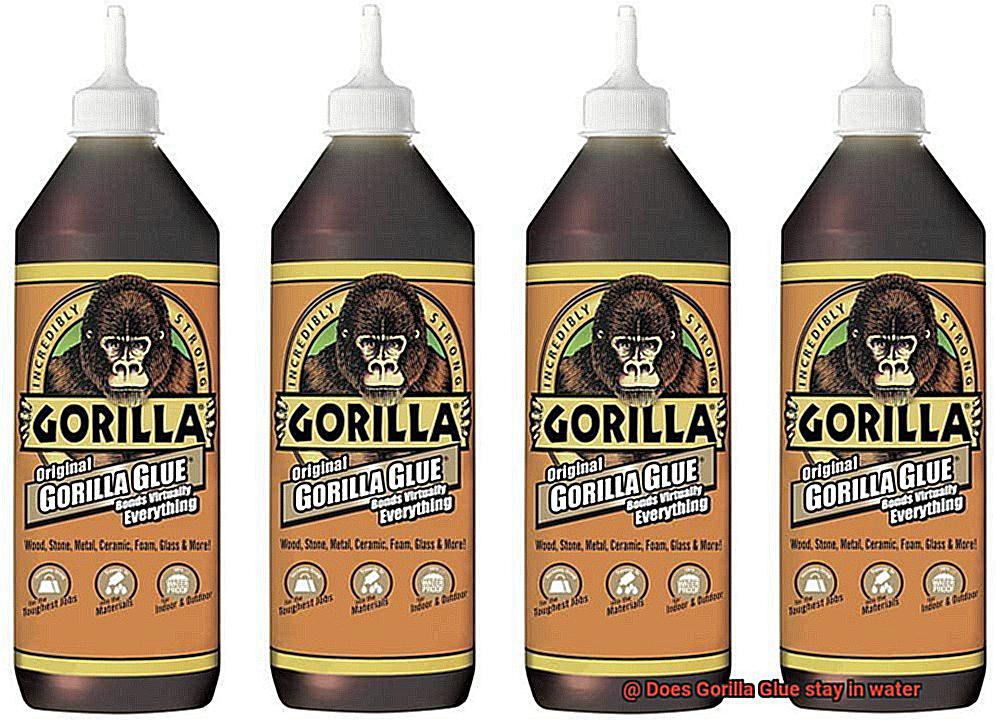
As an expert on the topic, I can confidently say that there are many advantages to using Gorilla Glue in wet conditions.
One major advantage of Gorilla Glue is its ability to bond even in the presence of moisture. Unlike other adhesives that lose their bonding strength when exposed to water, Gorilla Glue actually thrives in damp environments. This makes it the ideal adhesive for outdoor projects that may be exposed to rain or moisture, such as wood furniture, garden ornaments, or outdoor fixtures.
But that’s not all – Gorilla Glue is also incredibly versatile. It can bond a wide variety of materials including wood, metal, ceramics, plastics, and more. This makes it a go-to adhesive for many DIY enthusiasts and professionals alike. Plus, its exceptional strength means that it can withstand harsher conditions than other adhesives, making it a reliable choice for long-term projects.
Another advantage of using Gorilla Glue in wet conditions is that it can be used on surfaces that are not completely dry. This can save time and effort during projects, as you won’t have to wait for surfaces to dry before applying the adhesive. This feature also makes Gorilla Glue perfect for quick fixes on items that may be exposed to water or moisture.
Gorilla Glue not only bonds well in wet conditions but also dries clear and is resistant to water and heat once cured. This means that it won’t yellow over time or break down when exposed to extreme temperatures. It’s also waterproof when fully cured, making it perfect for projects that will be exposed to water or moisture on a regular basis.
Limitations of Using Gorilla Glue in Wet Conditions

If you’re a big fan of Gorilla Glue, you might be asking yourself if it’s the perfect adhesive for all your wet weather projects. While Gorilla Glue is known for its exceptional strength and waterproofing capabilities, there are some limitations that you should be aware of when it comes to bonding in wet conditions.
Firstly, one major limitation of using Gorilla Glue in wet conditions is that it takes longer to dry. The glue requires moisture to activate and cure properly, but excessive moisture can hinder the process and prolong the drying time, which can be a real headache if you need the bond to set quickly. This issue is further compounded in humid environments.
Secondly, Gorilla Glue may not adhere well to certain materials when they are wet. For example, if you’re trying to glue two wet pieces of wood together, the glue may not be able to penetrate the fibers and create a strong bond. In some cases, it may be necessary to wait until the materials have dried before applying the glue.
Lastly, prolonged exposure to water can cause Gorilla Glue’s bond to weaken or break down completely. While it’s great for normal conditions, it may not hold up under constant exposure to moisture. This makes it less suitable for underwater repairs or outdoor projects exposed to rain or snow.
Tips for Using Gorilla Glue in Wet Conditions
Although Gorilla Glue is renowned for its strength and versatility, using it in damp conditions can be challenging. But don’t fret. We have compiled some expert tips to help you achieve a robust and long-lasting bond.
The first and most crucial step is to ensure that the surface you are bonding is clean and dry. Moisture can impact the bonding process and weaken the strength of the bond. Therefore, it’s essential to wipe down the surfaces with a dry cloth and let them air dry completely before applying the glue.
Once you have ensured that the surfaces are dry, use a clamp or weight to hold the surfaces together while the glue sets. Gorilla Glue expands as it dries, which can cause a mess if it isn’t held in place. Apply enough pressure to form a tight bond and ensure that everything stays in place.
When working with Gorilla Glue in damp conditions, apply the glue sparingly to ensure that it cures properly. While Gorilla Glue is known for its strength, using too much of it can actually weaken the bond. Also, make sure to keep any excess glue away from water while it cures as it can foam up and create a mess.
It’s worth noting that Gorilla Glue takes longer to cure in damp conditions than in dry conditions. So, make sure you allow for extra curing time before using the bonded surface. If you’re working in cold or humid conditions, take note that it may take even longer for the glue to dry and cure correctly. Therefore, allowing enough time for the glue to fully cure before subjecting it to any stress or pressure is vital.
Finally, if you plan on frequently using Gorilla Glue in wet conditions, consider using waterproof epoxy instead of regular Gorilla Glue. Epoxy is specifically designed to bond in damp conditions and can provide a stronger and more durable bond than regular glue.
Alternatives to Gorilla Glue for Waterproofing Projects
If you’re working on a waterproofing project, chances are you’ve heard of Gorilla Glue. While it’s certainly a popular choice, it’s not the only option out there. In fact, there are several alternatives that can provide just as effective results.
One such alternative is epoxy. This two-part adhesive creates a powerful bond and is well-suited for use in wet environments. Whether you’re working with metal, wood, or plastic, epoxy can be used to create a strong hold. Additionally, it’s great for patching leaks in pipes or sealing cracks in concrete.
Another option to consider is polyurethane adhesive. This adhesive is known for its flexibility and ability to expand and contract with changes in temperature. It’s versatile enough to be used on surfaces such as metal, wood, and rubber, making it a popular choice in construction and automotive settings.
For those who prioritize eco-friendliness, plant-based adhesives may be the way to go. Soy-based adhesives and natural latex glue are both renewable resources that do not contain harmful chemicals. These adhesives are perfect for those who want to maintain an environmentally-conscious approach to their projects.
Also Read: Is Gorilla Super Glue Waterproof?
Conclusion
To sum up, Gorilla Glue is a top-notch adhesive that can withstand wet conditions and create a robust bond. Its polyurethane-based formula reacts with moisture to form a tight seal that can resist water and heat once it’s cured. However, keep in mind that Gorilla Glue isn’t entirely waterproof and may lose its grip when submerged for an extended period.
When using Gorilla Glue in damp conditions, you need to ensure proper surface preparation, application, and curing time. It’s crucial to clean and dry the surfaces before applying the glue. Using clamps or weights can help hold the surfaces together while the glue sets, and applying the glue sparingly ensures proper curing.
Although Gorilla Glue is a popular choice for waterproofing projects, there are other options such as epoxy or polyurethane adhesive that can deliver equally effective results. For those who prioritize sustainability, eco-friendly alternatives like soy-based adhesives or natural latex glue are also available.
All in all, whether you’re fixing outdoor furniture or sealing leaks in pipes, Gorilla Glue is an excellent option for projects that require exposure to moisture or damp conditions.

